Via Egnatia was a Roman road that started from the Adriatic Sea and went all the way to the Black Sea. Its remains could be seen in today’s Macedonia, Greece, and Albania. The road was built in the second century BC. The road owes its name to the Roman proconsul Gnaeus Egnatius, who oversaw its construction. The Via Egnatia was an important trade route, one of the most important in the Roman Empire.
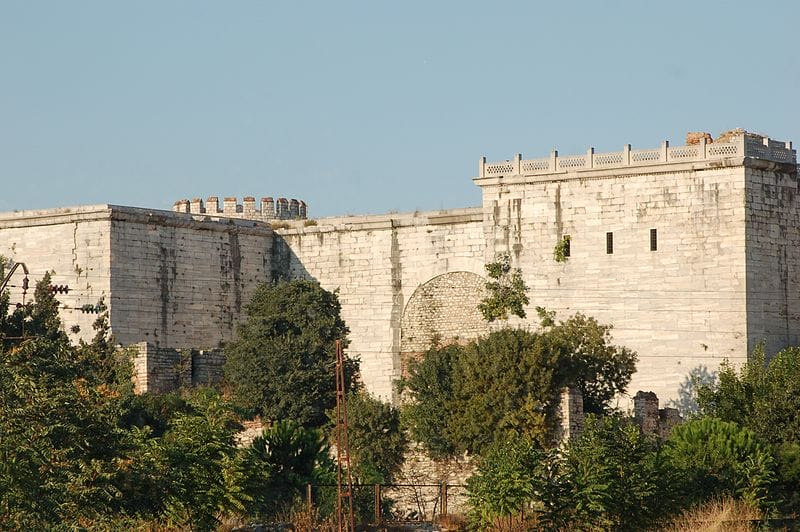
The most important cities, that served as stops for travelers were Thessaloniki, Philippi, and Constantinople. The road was also a symbol of Roman power and influence in the region. Today, many of these ancient sites along the Via Egnatia are popular tourist destinations, and many Roman Empire enthusiasts often visit them.
Key Takeaways
- Via Egnatia was a Roman road that connected the Adriatic Sea with the Black Sea, running through modern-day Macedonia, Greece, and Albania.
- Via Egnatia was an important trade route that facilitated the movement of goods, people, and armies across the Roman Empire, and played a significant role in the historical development of the region.
- Today, many of the ancient sites along the Via Egnatia are popular tourist destinations, attracting visitors from around the world.
Historical Significance
Construction and Founders
As stated at the beginning, the road was commissioned by Gnaeus Egnatius, a Roman proconsul of Macedonia, in 146 BC, and was completed in 120 BC. It was a monumental project in the Roman Republic, as the road spanned over 1,100 kilometers and had to cross several mountain ranges and rivers since the Balkans is full of mountains.
The road was built to further promote trade and communication between Rome and the eastern parts of the Roman Empire, particularly Greece and Asia Minor. But in the future, there was one city that was the most important on this road. The second Rome, Constantinople, became the destination for most of the travelers. Via Egnatia was also used by Roman armies to move troops and supplies during military campaigns, especially in the later period, when the long campaigns in the East needed many soldiers.
During the Roman Republic, Via Egnatia was used by several famous people, including Pompey, Caesar, Cassius, and Brutus. Later, the road was expanded by several emperors, mainly Octavian. Also, the end of the Roman Empire didn’t mean the end for this road since it was also used by the Crusaders, on their way to the Holy Land.
Today, Via Egnatia is a historical and cultural monument. It remains an important symbol of the Roman Empire’s power and influence. The road’s impact on history and culture is also recognized by UNESCO, which has designated Via Egnatia as part of the “Cultural Routes of the Council of Europe.”
Now, let’s jump to the tourist information and what we can see if we go down that road.
Ancient City of Philippi
Philippi was a city located in the eastern part of the Roman Empire, near the island of Tasos, and was an important stop on the Via Egnatia. The city was founded by Philip II of Macedon, to whom it owns its name, in the 4th century BC, and it played a significant role in the history of the region.
Another important feature of Philippi is the Forum, that still shows the significance of the city. The Forum was surrounded by shops, temples, and other public buildings, since it was a hub of activity for merchants, politicians, and other citizens.
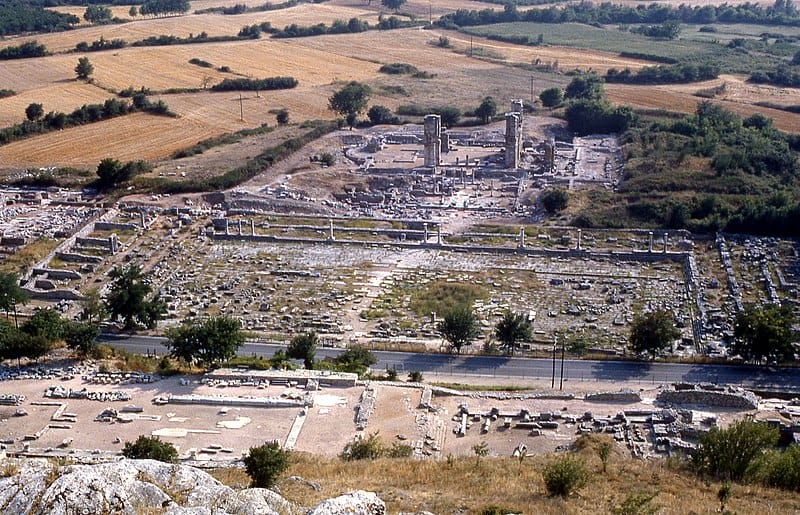
Source: Mark Landon (photographed in July 1985; digitized in 2021), CC BY 4.0 https://creativecommons.org/licenses/by/4.0, via Wikimedia Commons
But the history of the city doesn’t end here, Philippi also had several early Christian basilicas, which were built in the 4th and 5th centuries AD. These basilicas show how Phillipi was important in the early Christian world and represent a popular destination for religious pilgrims.
The Battle of Philippi, which took place in 42 BC, also brought more historical popularity to the city. The battle was fought between the forces of Mark Antony and Octavian against the forces of Brutus and Cassius, who had assassinated Julius Caesar. It was still the time when Octavian and Mark Antony were allies. They emerged victorious and in some way, they marked the end of the Roman Republic right there.
Today, Philippi is part of the modern city of Kavala and a tourist center of the city because of its ancient history.
Rotunda of Galerius
The next stop should be the Rotunda of Galerius. It is an ancient building located in Thessaloniki, Greece, built in the early 4th century AD as a mausoleum for Emperor Galerius. The Rotunda still stands to the test of time, and it is considered to be one of the most important monuments of the city. And Thessaloniki is full of cultural and historical monuments.
Over the centuries, the Rotunda has been used for various purposes. It was a church dedicated to Saint George, then a mosque, and today, it is a museum, attracting visitors all across the world.
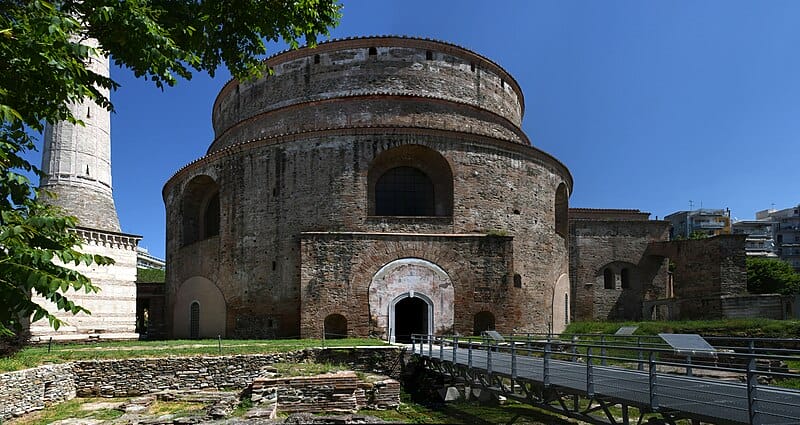
Source: Herbert Frank from Wien (Vienna), AT, CC BY 2.0 https://creativecommons.org/licenses/by/2.0, via Wikimedia Commons
The maximum height of a dome is around 30 meters, making it one of the largest in the world. The interior is painted with mostly Christian images and beautiful mosaics showing scenes from the life of Jesus Christ and other religious figures.
The Rotunda of Galerius is located at the crossroad of the Via Egnatia and the ancient road that leads to the port. Even the location itself make it an important landmark in the city.
Arch of Galerius
We stay in Thessaloniki to see the Arch of Galerius. It was built in the early 4th century AD to commemorate the victory of Emperor Galerius over the Persians. The arch itself is a part of the Via Egnatia.
The Arch of Galerius is a massive structure, almost 25 meters in height and 23 meters in width. It was built from brick and marble, which helped its endurance. This arch is an important historical source, showing images of the life of Emperor Galerius.
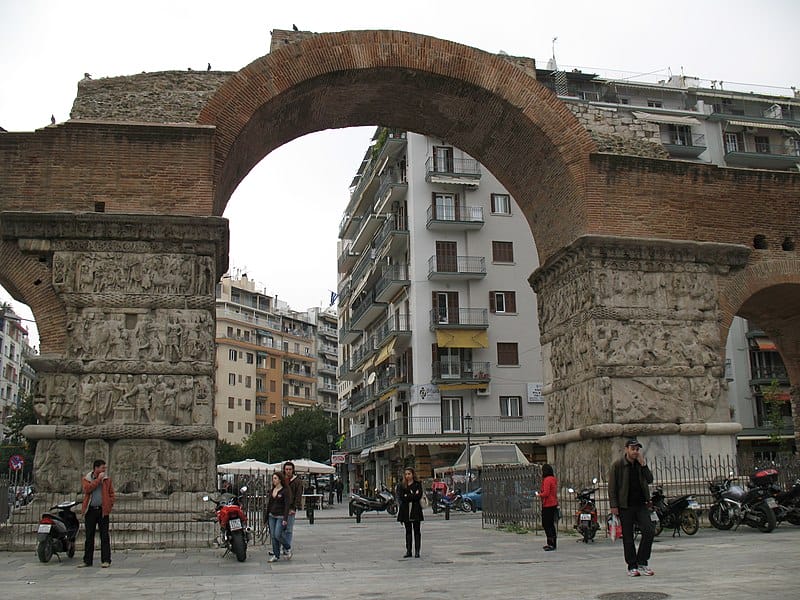
Source: macrolepis, CC BY 3.0 https://creativecommons.org/licenses/by/3.0, via Wikimedia Commons
In the beginning, the arch was part of a larger complex that included a palace, a hippodrome, and a mausoleum. Emperor Galerius really loved this city and he made the palace for himself, and even the mausoleum as his final resting place. The hippodrome was used for chariot races and fun.
Ancient Theater of Kavala
Now, we head back to Kavala. Also known as Neapolis, Kavala is a city in northern Greece. We are here to check on one of the city’s most notable landmarks, the Ancient Theater of Kavala, which dates back to the Hellenistic period.
It was built during the 2nd century BC and could accommodate up to 6.000 people. It was used for all sorts of performances. Sadly, the theater was abandoned during the Roman period and was only rediscovered in the early 20th century.
Today, the Ancient Theater of Kavala is a popular tourist attraction and it is once again used for theatrical performances.
Roman Amphitheater of Durrës
The Roman Amphitheater of Durrës is in the city of Durrës in Albania, once a part of the Roman Empire. It is believed to have been built sometime in the 2nd century AD and is one of the largest amphitheaters in the Balkans. It had a seating capacity of around 15,000 people and was divided into different sections based on social status, like almost all big Roman amphitheaters.
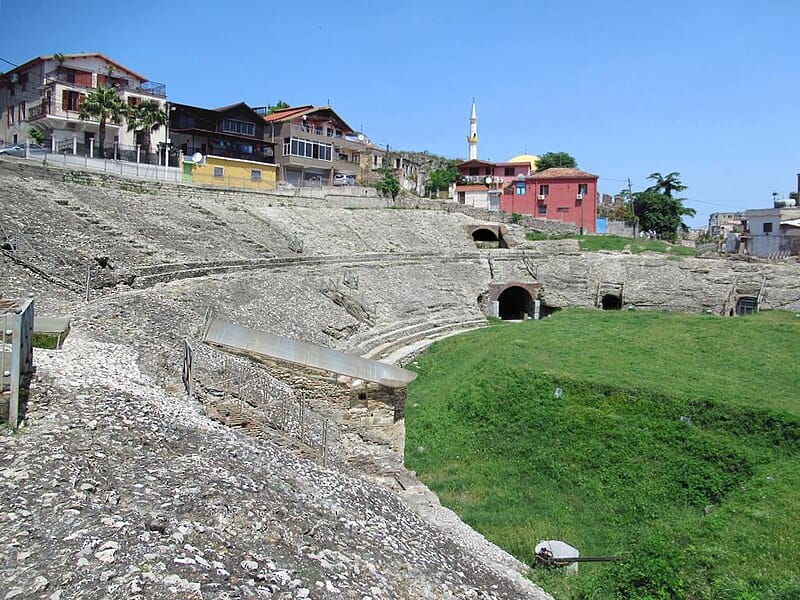
Source: David Stanley from Nanaimo, Canada, CC BY 2.0 https://creativecommons.org/licenses/by/2.0, via Wikimedia Commons
Made from stone and concrete, it has a unique design with underground tunnels and rooms that were used for storing equipment and animals. The tunnels also served as a way for the gladiators and animals to enter the arena without being seen by the audience which made wonders for dramatic effect.
The arena itself was surrounded by a high wall that was used to protect the audience from the animals during the hunts. Today, the Roman Amphitheater of Durrës is a popular tourist attraction and a reminder of the rich history of the region, although not in so great shape. Visitors can explore the tunnels and parts of the arena and get a glimpse of what life was like during the Roman Empire.
Ancient City of Stobi
The Ancient City of Stobi is a well-preserved archaeological site located in the Republic of North Macedonia. On the banks of the Vardar River, there is a lot to see, and also Stobi is a famous North Macedonian wine.
In ancient times, Stobi was a city known for its impressive amphitheater, which could accommodate up to 7,000 spectators. But that wasn’t all, there were also several basilicas, including the Episcopal Basilica, which is still one of the largest and most impressive structures in the city. The basilica features intricate mosaics and frescoes and attracts many tourists.
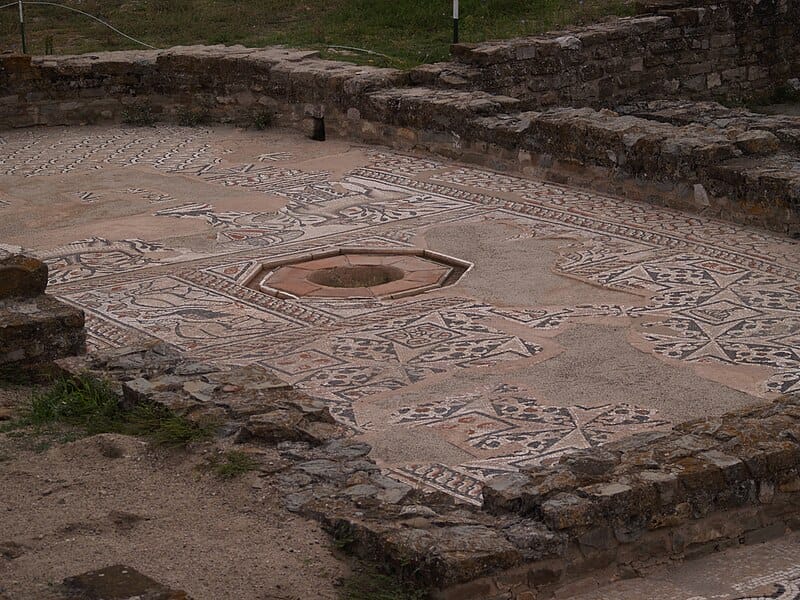
Source: d_proffer, CC BY 2.0 https://creativecommons.org/licenses/by/2.0, via Wikimedia Commons
Visitors to Stobi can also explore the city’s ancient streets, which are lined with well-preserved buildings and structures. The city’s water supply system, which includes a network of underground tunnels and reservoirs, is another impressive feature of the site. Basically, Stobi is a must for history lovers.
Ancient Theatre of Ohrid
We stay on the Via Egnatia and also in North Macedonia. Here, we visit, the Ancient Theatre of Ohrid. It is a significant historical and cultural landmark located in the city of the same name. The theatre was built during the Roman period in the 2nd century AD.
In this heaven on earth, the theatre was constructed on the slopes of the Saraishte hill, overlooking the city and the lake. It has a capacity of approximately 4,000 seats. Enjoy the stunning view.

Source: Sharon Hahn Darlin, CC BY 2.0 https://creativecommons.org/licenses/by/2.0, via Wikimedia Commons
Unlike the ones shown before, this theater has a semi-circular seating arrangement. The theatre was an important part of the cultural and social life of Ohrid during the Roman period, and it continued to be used throughout the Byzantine and Ottoman periods. However, it fell into disuse and was abandoned in the 19th century. Today, it is one of the historical landmarks in this tourist city,
Hippodrome of Constantinople
We finish our journey in the most populated city in Europe. The city, which is also in Asia. First, we should check out the Hippodrome of Constantinople. It was the highlight of Byzantine public life and entertainment. In the very heart of the city, it was the venue for chariot races, athletic contests, and political gatherings. The Hippodrome was a massive arena that could seat up to 100,000 spectators, and it was the largest and most impressive public space in Constantinople. From there, the riots started and it shaped the history of the city and Europe.
One of the most prominent features of the Hippodrome was the Egyptian Obelisk, which was brought to Constantinople by Emperor Theodosius in the 4th century. It originally stood in the Temple of Karnak in Luxor, as a symbol of the power and wealth of ancient Egypt. Besides the Obelisk, the Serpent Column also attracted attention. It was a bronze statue of three intertwined serpents. It was also taken away from its first place, but much closer. It was built in the 5th century BC, it was taken from Delphi in today’s Grecce, and it was a symbol of the victory of the Greeks over the Persians. From 324, it is located in Constantinople.
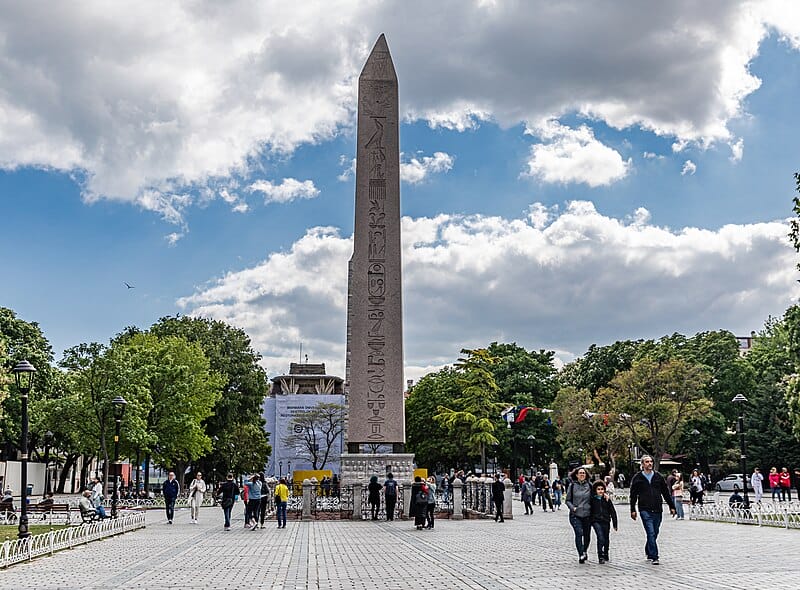
Source: Ninara, CC BY 2.0 https://creativecommons.org/licenses/by/2.0, via Wikimedia Commons
The Hippodrome was also the site of many important political events in Byzantine history. It was here that the Nika Riot took place in 532 AD, which nearly destroyed Emperor Justinian I. Also, many emperors were crowned here and they celebrated their victories. The Hippodrome was a place where the people of Constantinople could gather and express their opinions, and it was a vital part of the city’s social and political life.
Today, little remains of the Hippodrome except for a few fragments of the seating area and the Egyptian Obelisk. However, its legacy lives on in the many historical accounts and descriptions of the events that took place there.
Walls of Constantinople
The Walls of Constantinople, also known as the Theodosian Walls, mark the last highlight of our trip. These walls were a series of defensive stone walls that surrounded and protected Constantinople from invaders for centuries. They were considered the strongest walls in the Middle Ages. The construction began during the reign of Emperor Theodosius II in the early 5th century and continued through the reign of Emperor Justinian I in the 6th century.
There were three distinct layers, each with its own set of towers and gates. The first layer was the outer wall, which was the largest and most heavily fortified. It was around 5 meters thick and stood at a height of 12 meters. The second layer was the middle wall, slightly thinner and shorter than the outer wall. The third and final layer was the inner wall, the thinnest and shortest of the three.
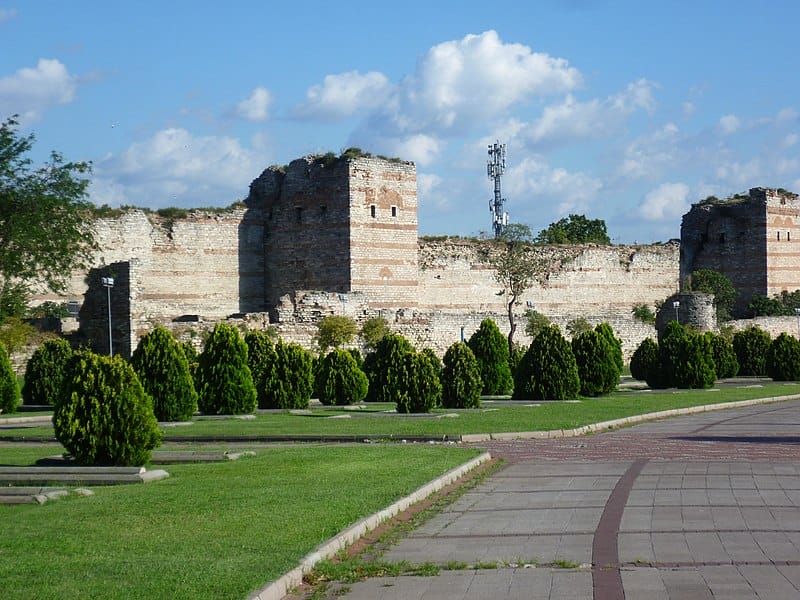
Source: Radosław Botev, CC BY 3.0 PL https://creativecommons.org/licenses/by/3.0/pl/deed.en, via Wikimedia Commons
The Walls of Constantinople were not only a physical barrier but also a symbol of the city’s strength and resilience. They were so effective that the city was able to withstand numerous sieges and attacks throughout its history, including those by the Persians, Arabs, and Crusaders. The most famous gate was the Golden Gate, on the western side of the city. It served as the ceremonial entrance for emperors.
People Also Ask:
What historical significance does the Via Egnatia hold?
The Via Egnatia was a vital trade and military route that connected the Eastern and Western parts of the Roman Empire. It was constructed in the 2nd century BCE by the Roman consul Gnaeus Egnatius, and it played a crucial role in the spread of Roman culture and influence in the Balkans and beyond. Via Egnatia was also significant in the spread of Christianity in the region, as it was used by the Apostle Paul on his second missionary journey.
How can one follow the original route of the Via Egnatia today?
Although much of the original route of the Via Egnatia has been lost to time, there are still some sections of the road that can be followed today. The most well-preserved section of the road is located in the city of Thessaloniki, where it is known as the “Decumanus Maximus.” Other sections of the road can be found in various parts of Greece, Turkey, and Albania.
What languages were historically spoken along the Via Egnatia?
The Via Egnatia passed through many different regions and territories, each with its own unique language and culture. Some of the languages that were historically spoken along the road include Greek, Latin, Thracian, Illyrian, and Albanian.
What are the key archaeological sites found along the Via Egnatia?
There are many important archaeological sites located along the Via Egnatia, including the ancient city of Philippi, the Roman city of Stobi, and the ancient Greek city of Apollonia. These sites offer a glimpse into the rich history and culture of the region, and they are popular destinations for tourists and history enthusiasts.
How has the Via Egnatia influenced modern tourism in the region?
The Via Egnatia has played a significant role in the development of tourism in the Balkans and beyond. Via Egnatia has been the subject of numerous books, documentaries, and travel guides, and it has inspired countless travelers to explore the region and learn more about its history and culture. Today, many of the towns and cities along the route of the Via Egnatia rely heavily on tourism for their economic survival.
What is the connection between the Via Egnatia and the city of Philippi?
The ancient city of Philippi was a major center of commerce and culture in the region, and it played a key role in the spread of Christianity in the Balkans. The city was also an important stop along the Via Egnatia, and it was home to a thriving market and trading center. Today, visitors to Philippi can explore the ruins of the ancient city and learn more about its rich history and culture.
Hello, my name is Vladimir, and I am a part of the Roman-empire writing team.
I am a historian, and history is an integral part of my life.
To be honest, while I was in school, I didn’t like history so how did I end up studying it? Well, for that, I have to thank history-based strategy PC games. Thank you so much, Europa Universalis IV, and thank you, Medieval Total War.
Since games made me fall in love with history, I completed bachelor studies at Filozofski Fakultet Niš, a part of the University of Niš. My bachelor’s thesis was about Julis Caesar. Soon, I completed my master’s studies at the same university.
For years now, I have been working as a teacher in a local elementary school, but my passion for writing isn’t fulfilled, so I decided to pursue that ambition online. There were a few gigs, but most of them were not history-related.
Then I stumbled upon roman-empire.com, and now I am a part of something bigger. No, I am not a part of the ancient Roman Empire but of a creative writing team where I have the freedom to write about whatever I want. Yes, even about Star Wars. Stay tuned for that.
Anyway, I am better at writing about Rome than writing about me. But if you would like to contact me for any reason, you can do it at contact@roman-empire.net. Except for negative reviews, of course. 😀
Kind regards,
Vladimir
